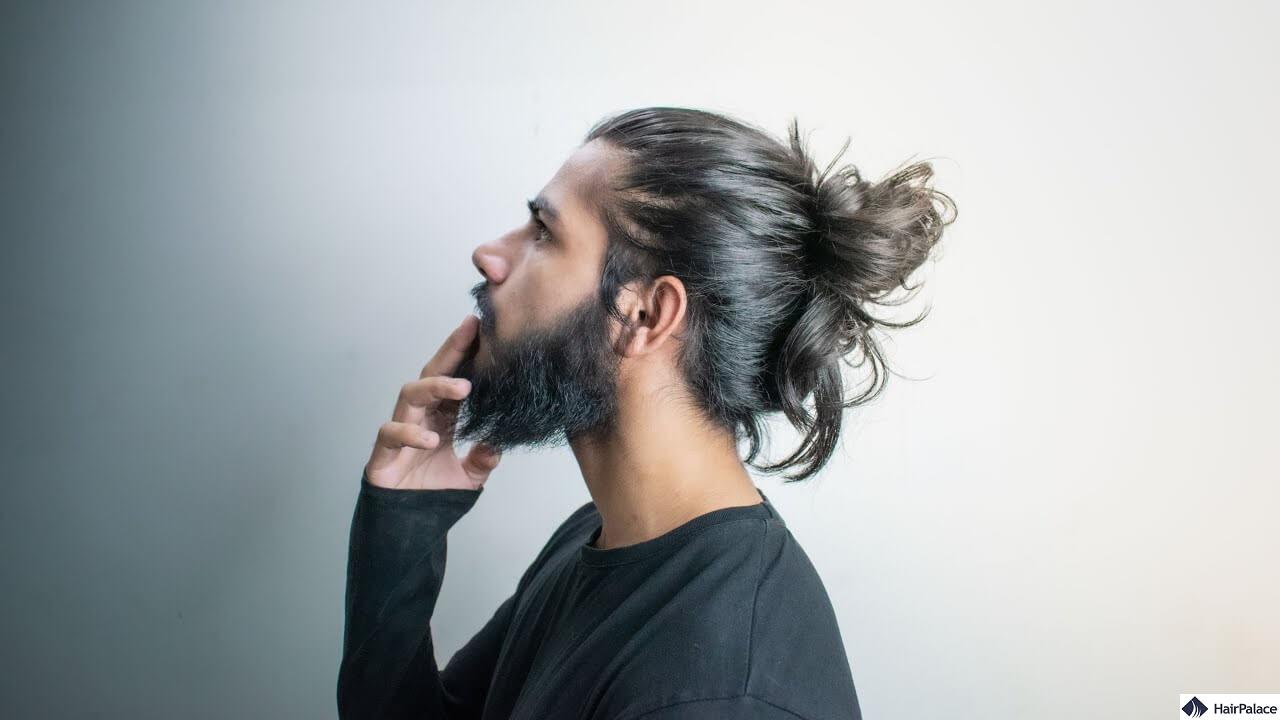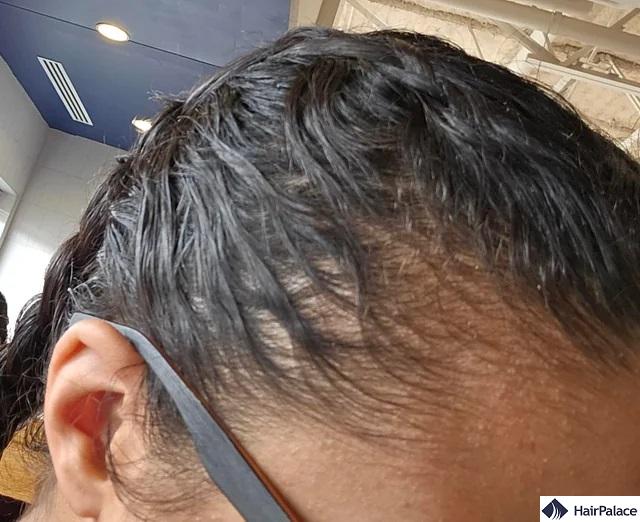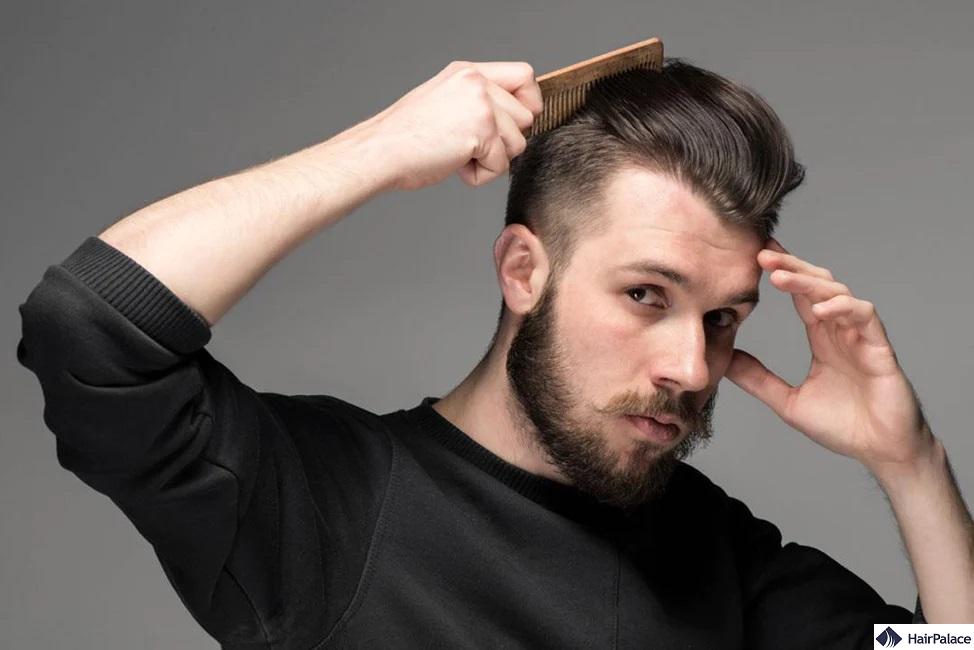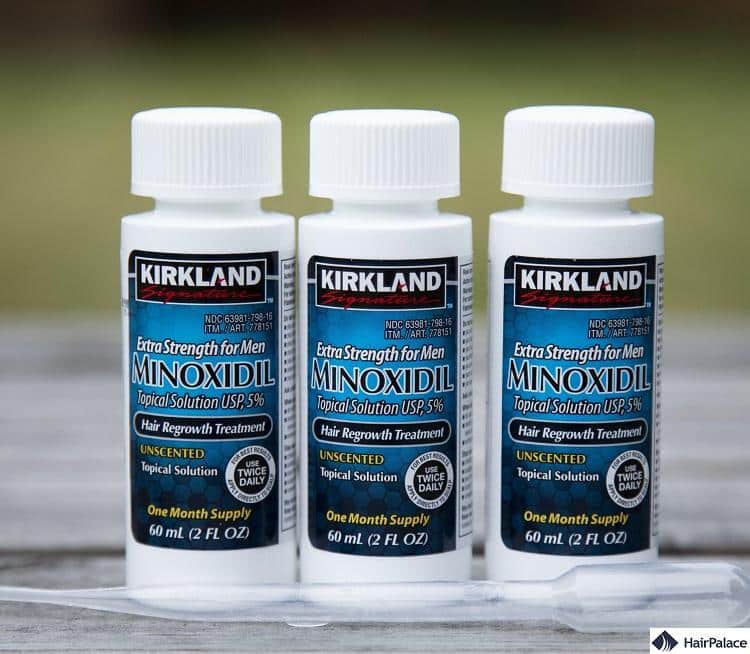Can a Man Bun Cause Hair Loss?

Man bun hair loss, also known as traction alopecia, is a form of hair loss triggered by the constant pull and tension on hair follicles.
This article delves into the phenomenon, exploring how the beloved top knot can sometimes lead to unintended consequences for your hair.
We’ll discuss the science behind traction alopecia, identify signs to watch for, and offer practical advice on how to enjoy this trendy hairstyle without compromising the health of your hair.
Does a man bun cause hair loss?
Wearing a man bun can potentially cause hair loss if it’s styled too tightly. This type of hair loss is known as traction alopecia.
It occurs when there’s constant tension on the hair follicles, leading to damage and eventually, hair loss.
Traction alopecia

Thinning hair or man bun baldness occurs when the style is worn consistently over a long period.
The constant tension exerted on the hair follicles can lead to inflammation and weakening of the hair roots, which eventually may cause the hair to fall out.
When caught early, treating traction alopecia is typically successful.
However, if this hair loss condition goes untreated it may lead to permanent hair loss and widespread baldness.
Symptoms of man bun hair loss (traction alopecia) include:
- Gradual hair thinning, particularly around the forehead, temples, and nape where the tension is greatest.
- Small pimples appear at the base of the existing hair, especially where it’s pulled tightly.
- Redness, itching, and pain on the scalp in the areas of tension.
- In severe cases, scarring on the scalp where hair has been lost.
Prevention is key to managing traction alopecia.
This involves adopting gentler hairstyles and allowing the hair to rest and recover by wearing loose more frequently.
Another thing to keep in mind is that hair loss is most frequently caused by male pattern balding, also known as male pattern baldness.
Consulting with a doctor or a trichologist can rule out under conditions and pinpoint the exact cause of your hair loss.
How to stop man bun baldness

To prevent or stop man bun hair loss, it’s essential to adopt a gentler approach to hairstyling.
Doing away with tight buns and tight ponytails can significantly reduce tension on your follicles, causing less hair breakage and hair loss.
It’s also beneficial to vary your hairstyles to distribute pressure evenly across different parts of your scalp.
This practice helps avoid constant strain on the same areas, reducing the risk of hair loss.
To summarize things:
- Avoid tight buns; only use bobby pins, hair clips or headbands.
- Don’t make your buns in the same place, allow your follicles to recover from strain
- Never use tight hair bands or clips, always opt for looser styles when you can
Incorporating gentle hair care products into your routine and avoiding harsh chemical treatments can further protect your hair from weakening and falling out.
Conditioning treatments can play a vital role in keeping each hair follicle strong and healthy.
Giving your hair and scalp periodic rests from any tight hairstyles allows them to recover from any tension they’ve been subjected to.
How to restore hair loss after wearing a top knot or man bun
Restoring hair loss caused by wearing a top knot or man bun, particularly if it has led to traction alopecia, involves a complex approach.
Here’s how to address and potentially reverse the condition:
1. Hairstyling habits
The first and most crucial step is to stop wearing your hair in a way that causes tension.
If you’re not willing to completely give up on top knots, ensure they’re worn loosely and do not pull on the scalp.
Alternating hairstyles can also help relieve constant pressure on the same areas.
You should also avoid the excessive use of styling tools such as hair gels, or wax as this can further damage your hair.
2. Scalp care
Certain scalp infections and conditions may contribute to your hair loss. Introduce a gentle hair care routine. Use mild shampoos and conditioners that nourish the scalp and hair.
Consider products specifically designed to promote hair growth and thickness. Scalp massages can improve blood circulation, encouraging hair regrowth by stimulating the hair follicles.
3. Nutrition
A well-balanced diet rich in vitamins and minerals supports hair growth. Focus on foods high in vitamins A, C, D, E, zinc, iron, omega-3 fatty acids, and protein.
4. Hair growth products and medications

Minoxidil (Rogaine) can be effective in promoting hair growth. It’s available over the counter and can be applied directly to the scalp.
For more severe cases, a dermatologist may prescribe finasteride (Propecia), an oral medication. These treatment options are particularly effective in the early stages of hair loss.
5. Low-level laser therapy
LLLT devices, such as laser combs and helmets, use therapeutic laser light to stimulate hair follicles and promote regrowth.
This non-invasive treatment option has shown promise in treating hair loss, including hair loss due to man buns.
6. Platelet-rich plasma (PRP) therapy
PRP therapy involves injecting your scalp with a concentration of your platelets to stimulate hair growth.
This treatment can be particularly effective for promoting hair regrowth in areas affected by traction alopecia.
7. Avoid harsh treatments
Steer clear of chemical treatments, such as dyes and relaxers, which can exacerbate hair loss.
Similarly, minimize using heat styling tools that can weaken hair and make it more prone to breaking.
8. Stress management
Stress can contribute to hair loss. Incorporating stress-reduction techniques, such as exercise, meditation, and yoga, can have a positive effect on overall hair health.
9. Consult a professional
If hair loss persists, consult a dermatologist or trichologist.
These specialists can offer a diagnosis, and recommend personalized treatment plans such as medication or a hair transplant.
Last medically reviewed on April 11th, 2025
- Shimizu Y, Ntege EH, Sunami H, Inoue Y. Regenerative medicine strategies for hair growth and regeneration: A narrative review of literature. Regen Ther. 2022 Oct 31;21:527-539. doi: 10.1016/j.reth.2022.10.005. PMID: 36382136; PMCID: PMC9637724.https://pubmed.ncbi.nlm.nih.gov/36382136/
- Afifi L, Oparaugo NC, Hogeling M. Review of traction alopecia in the pediatric patient: Diagnosis, prevention, and management. Pediatr Dermatol. 2021 Nov;38 Suppl 2:42-48. doi: 10.1111/pde.14773. Epub 2021 Aug 31. PMID: 34467569.https://pubmed.ncbi.nlm.nih.gov/34467569/
- Kim SR, Craiglow BG. Treatment of traction alopecia with oral minoxidil. JAAD Case Rep. 2022 Apr 1;23:112-113. doi: 10.1016/j.jdcr.2022.03.023. PMID: 35495975; PMCID: PMC9039860.https://pubmed.ncbi.nlm.nih.gov/35495975/


